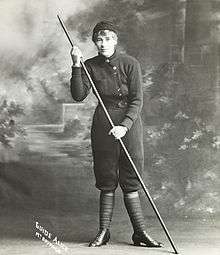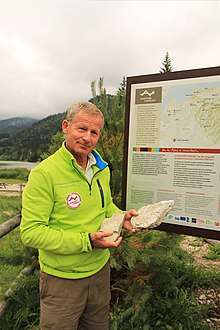Mountain guide
A mountain guide is a specially trained and experienced professional mountaineer who is certified by local authorities or mountain guide associations. They are considered to be high-level experts in mountaineering, and are hired to instruct or lead individuals or small groups who require this advanced expertise. This professional class of guides arose in the middle of the 19th century when Alpine climbing became recognized as a sport.
-Josef_Frey(R).jpg)


Attributes
Knowledge
Supporting these are the theory and practice of:
- Snowcraft
- Weather appreciation and interpretation
- Navigation
- Risk assessment
- Avalanche hazards
- First aid
Certification in the IFMGA
The title of IFMGA Mountain Guide is (in most countries) reserved for individuals who have received full certification through their country's national mountain guides association of which the curriculum and training are approved by the International Federation of Mountain Guides Associations (IFMGA). Certification is earned through a rigorous examination process encompassing rock climbing, alpine climbing and ski mountaineering. Typically lasting between 3 and 7 years, mountain guide certification requires a high level of commitment, dedication and technical skill to achieve.
Services
In addition to assuring safety, professional mountain guides frequently offer other desirable services to their clients. These services can significantly improve the alpine experience, especially when the client climber has limited time or equipment, lacks a qualified partner or is visiting an unfamiliar area. These additional mountain guide services may include:
- Precise local knowledge of mountain routes, weather, snow & glacier conditions;
- Specific training in alpine skills like off-piste skiing, avalanche awareness, rock climbing, ice climbing, mountain navigation & the proper use of mountain tools like ice ax, crampons, rope, climbing anchor systems, avalanche beacons, etc.;
- The ability to contact helicopters for remote ski mountaineering access or heli-skiing;
- Preferential access to various ski lifts and trams;
- Sometimes, more immediate access to use-limited features in areas like U.S. National Parks.
Organization
Mountain guides are commonly organized in national and international associations. The world's oldest guides association was formed in the Silesian Sudetes in 1817.[1] Also in Sudetes Franz Pabel received probably the first ever state confirmed guide licence.[2] First alpine guide association was Compagnie des guides de Chamonix, established in Chamonix in 1821, which banned women until the 1980s. It remains today the largest association with nearly 250 mountain guides. The biggest international organization is the International Federation of Mountain Guide Associations located in Gstaad, Switzerland.
See also
- Category of famous alpine guides
- Sherpa
- Association of Canadian Mountain Guides, American Mountain Guides Association, British Association of Mountain Guides, Union of International Mountain Leader Associations, UIAGM
References
- https://kpnmab.pl/history-of-the-giant-mountains
- Hose, T. A. (February 2016). Appreciating Physical Landscapes: Three Hundred Years of Geotourism. ISBN 9781862397248.
External links
- Accessibility Guidebook for Outfitters & Guides Operating on Public Lands United States Forest Service
- International Federation of Mountain Guide Associations (IFMGA/UIAGM) - www.ivbv.info
- The American Mountain Guide Association (AMGA) in Boulder, CO (USA) - www.amga.com
- Association of Canadian Mountain Guides (ACMG) Canmore, AB - www.acmg.ca